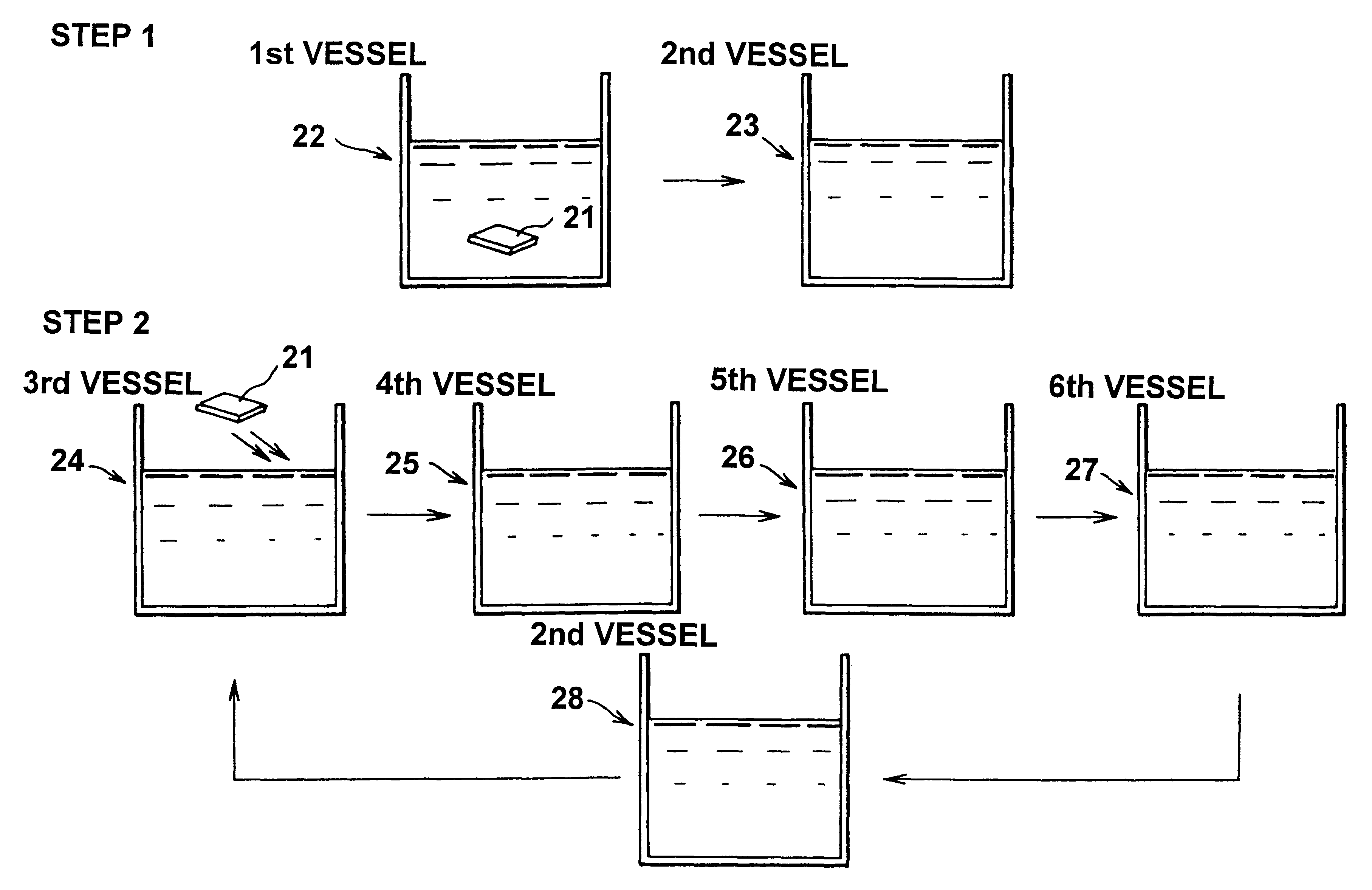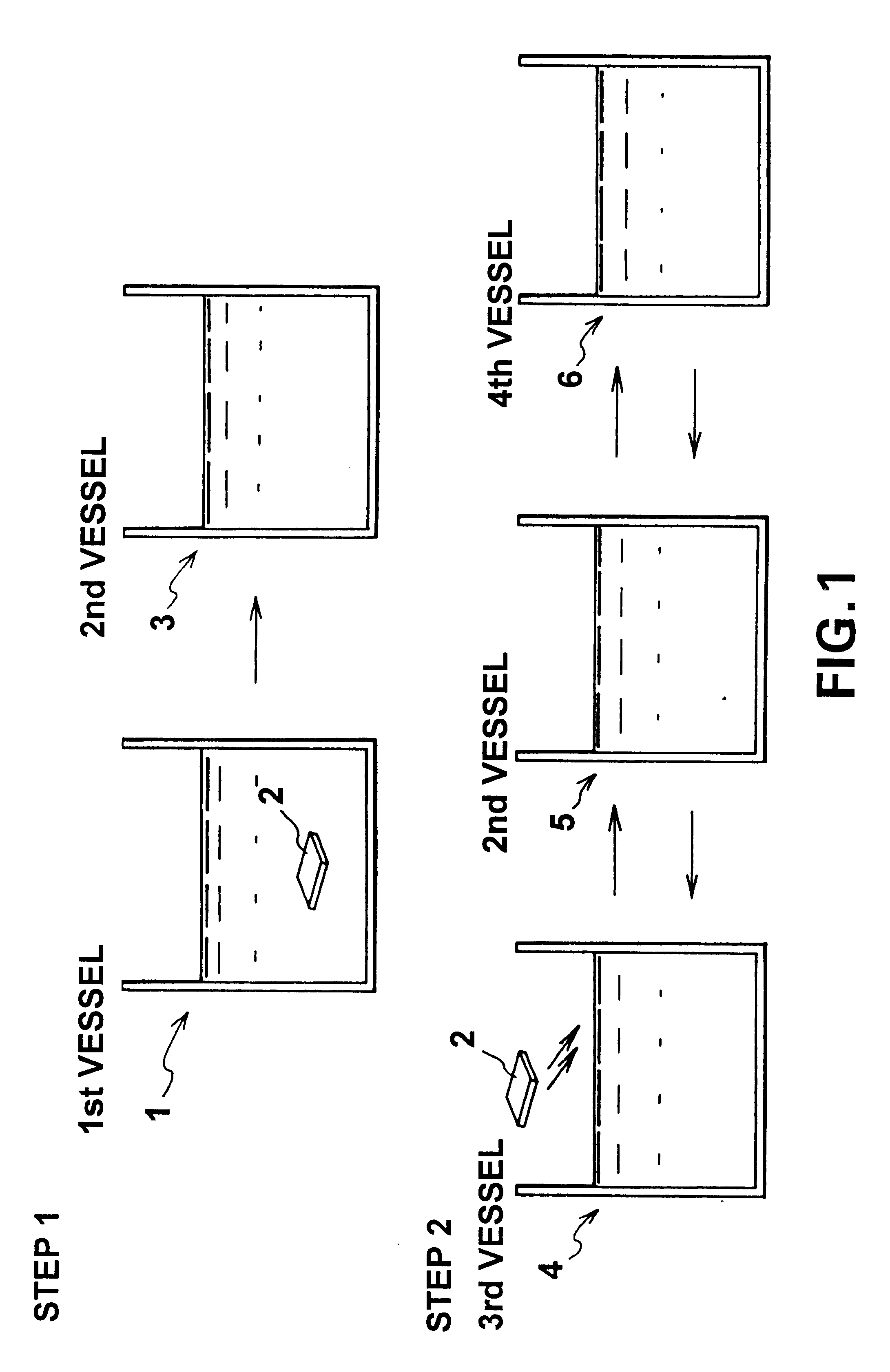Organic films and a process for producing fine pattern using the same
a technology of organic films and fine patterns, applied in the direction of liquid surface applicators, coatings, nanotechnology, etc., can solve the problems of insufficient acid and alkali resistance and durability of monomolecular films, inability to form limited combinations of functional groups and substrates, and weak bonding between substrates and monomolecular films
- Summary
- Abstract
- Description
- Claims
- Application Information
AI Technical Summary
Benefits of technology
Problems solved by technology
Method used
Image
Examples
embodiment 1
FIG. 1 illustrates one embodiment that creates an organic multilayer film according to this invention. In this figure, a first vessel 1 contains an ethanol solvent and a 1-mM 1,18-octadecylbisphosphonic acid [H.sub.2 O.sub.3 P(CH.sub.2).sub.18 PO.sub.3 H.sub.2 ](here after referred to as "ODBP) solution. To create an organic film, the surface of a GaAs substrate 2 is cleaned using a mixed solution of H.sub.2 O.sub.2 and H.sub.2 SO.sub.4, and the substrate is subsequently washed in pure water, dried, and then immersed in the solution contained in the first vessel. During the chemical adsorption of ODBP, the solution may be maintained at room temperature or may be heated. The solvent may be an organic solvent other than the ethanol solution, or may be pure water, but the organic solvent is preferable. The GaAs substrate 2 remains immersed in the solution contained in the first vessel 1 for several (as an example, four) hours, and is them removed therefrom and washed in pure ethanol co...
embodiment 2
FIG. 3 illustrates another embodiment that creates an organic multilayer film according to this invention. In this figure, a first vessel 8 contains an ethanol solvent and a 1-mM ODBP solution. To create an organic film, the surface of a GaSb substrate 7 is cleaned with a mixed solution of H.sub.2 O.sub.2 and H.sub.2 SO.sub.4, and the substrate is then washed in pure water, dried, and immersed in the solution contained in first vessel 8. The ODBP may be used in powder or liquid form. During the chemical adsorption of ODBP, the solution may be maintained at room temperature or may be heated. The solvent may be an organic solvent other than the ethanol solution, or may be pure water, but an organic solvent is preferable. The GaSb substrate 7 remains immersed in the solution contained in the first vessel 8 for several (five, as an example) hours, and is then removed therefrom and washed in pure ethanol contained in a second vessel 9 to remove the excess molecules deposited on the surfa...
embodiment 3
FIG. 4 illustrates yet another embodiment that creates an organic multilayer film according to this invention. In this figure, a first vessel 14 contains a 19-acetoxynonadecylphosphonic acid [H.sub.3 CO.sub.2 C(CH.sub.2).sub.17 PO.sub.3 H.sub.2 ] solution. To create an organic film, an InSb substrate 13 is cleaved in this solution, contained in first vessel 14. The surface of the substrate 13 can be processed as in Embodiment 1. 19-acetoxynonadecylphosphonic acid may be used in powder or liquid form. During the chemical adsorption of 19-acetoxynonadecylphosphonic acid, the solution may be maintained at room temperature or may be heated. The solvent may be an organic solvent other than the ethanol solution, or may be pure water, but an organic solvent is preferable. The InSb substrate 13 remains immersed in the solution contained in the first vessel 14 for several hours, and is then removed therefrom and washed in pure ethanol in a second vessel 15 to remove the excess 19-acetoxynona...
PUM
 Login to View More
Login to View More Abstract
Description
Claims
Application Information
 Login to View More
Login to View More - R&D
- Intellectual Property
- Life Sciences
- Materials
- Tech Scout
- Unparalleled Data Quality
- Higher Quality Content
- 60% Fewer Hallucinations
Browse by: Latest US Patents, China's latest patents, Technical Efficacy Thesaurus, Application Domain, Technology Topic, Popular Technical Reports.
© 2025 PatSnap. All rights reserved.Legal|Privacy policy|Modern Slavery Act Transparency Statement|Sitemap|About US| Contact US: help@patsnap.com



